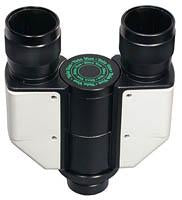
Other Mounts
The most common telescope mounts are the German equatorial mount, the fork mount, and the Dobsonian mount. Almost all telescopes sold have one of these types of mount, but there are a few other designs which are less common but...

The most common telescope mounts are the German equatorial mount, the fork mount, and the Dobsonian mount. Almost all telescopes sold have one of these types of mount, but there are a few other designs which are less common but...

Eyepieces determine the magnification and field of view of a telescope. Different eyepieces are used to view different objects. Some objects, such as nebulae and star clusters, appear quite large and are best viewed at low magnifications (which give a...

Standard eyepieces are relatively inexpensive designs which function very well. These include the types of eyepieces normally included with telescopes. The apparent field of view of a standard eyepiece is usually in the range of 40-50°. Early Eyepiece Designs The...

Wide field eyepieces (with apparent fields greater than 50°) were originally invented for military applications during World War I. The Erfle design consists of 5 or 6 lens elements and give an apparent field of 60-70°. They are relatively inexpensive...

One of the drawbacks to standard eyepiece designs is that at short focal lengths (high power on most telescopes), the eye relief is very short. Eye relief is the distance the observer's eye must be from the eyepiece lens (see...

Until recently, many new observers inquired about binocular viewers (binoviewers), but few actually bought them, primarily due to the expense. This is starting to change, with less-expensive binocular viewers becoming available. As with anything, you get what you pay for,...

Magnification is the most misunderstood aspect of telescopes, but not only by beginners. New telescope users often assume that more magnification gives a better view. They quickly learn that this is rarely true, and that on the contrary, lower power...

Two types of filters are often used to enhance planetary detail. The most popular method is to use a neutral density or polarizing filter to cut down the glare from bright objects like the moon and Venus. There are also...

Might as well get the obligatory warning out of the way. The sun generates more energy in one second than all the power plants on Earth could create in a million years. It's really, really, really bright and without a...

Light pollution filters and nebula filters are used to enhance the view of deep sky objects. They both work in a similar manner, but are intended for slightly different purposes. In fact, nebula filters really are just a type of...


Below are some of the handiest accessories you can get to make your observing easier and more enjoyable. Most are considered must-haves by experienced observers. So read on to see what you might need to enhance your stargazing! Reflex Finderscope...